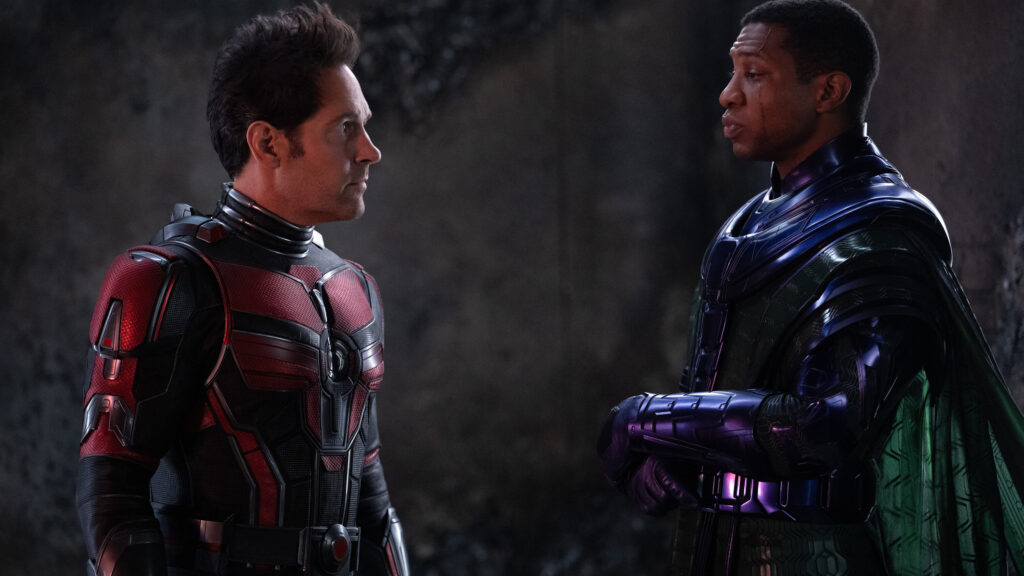Belen Yudess ’25
Staff Writer
If Harvey Mudd knew what was good for them, they would start admitting ants into their quantum theory classes. Confused yet? Equally mystified or entertained by that sentence? If so, then that sums up the experience of watching this midnight sugar high hallucinogen of a film.
Ant Man and the Wasp: Quantamania came out Feb. 17, becoming the third movie in the Ant Man franchise, 31st film in the Marvel Cinematic Universe (MCU), and the beginning of phase five of the MCU. The movie is focused on Ant Man’s (Paul Rudd) life following the events of Avengers: Endgame, specifically his relationship with his teenage daughter Cassie (Kathryn Newton) and his internal struggle between his newfound fame, ego, and his reluctance to still be a hero for the “little guy.” Once the characters enter the quantum realm, the plot itself is a lot like my cinnamon bread avocado toast with strawberry jelly, cheese, and everything bagel seasoning: absolutely disastrous but fun if you don’t think too hard about it.
The movie began as most Marvel films do: a fun-loving montage with a corny or classic 80’s song in the background. As Lang reminisced about his days valiantly fighting at Captain America’s side to a room full of devoted seven-year-old fans and their doting mothers, he receives a call saying Cassie has landed herself in jail after using Pym technology to shrink a police car during a protest. This leads into a run-on of scenes depicting Lang’s over-the-top self-praise much to the annoyance of Cassie who seems to be a self-aware activist.
Right off the bat, it seems Marvel is using Ant Man (of all movies) as a social and political commentary. Marvel projects like Ms. Marvel and Black Panther do an excellent job at providing representation for communities of color and the industry is making strides to include characters that are typically not found in mainstream media, but that is not what Ant Man is known for.
Lang’s goofy personality, banter with Hank, and scheming with the Hornets (whose absence was greatly noted in this film) has been what the storyline has previously thrived from. Yet, Quantamania tries to fit in several broad issues while also showcasing its impressive amounts of CGI and introducing its star-studded cast.
Throughout the film, Ant Man, Cassie, Hope (Evangeline Lily), Hank (Michael Douglas), and Janet (Michelle Pfeiffer) traverse different regions of the quantum realm whose inhabitants were displaced and preparing for eradication by Kang the Conqueror (Johnathan Majors). Although Ant Man is initially hesitant to help these quantum folks take back their land and defeat Kang, he eventually comes around after Cassie, in true teenage activist fashion, exclaims, “Even though it’s not our problem, that doesn’t mean it isn’t happening.”
While it is important to recognize difficult histories while mobilizing youth to use their voice and take action against injustices they see in the world, Quantumania’s attempts to take on this challenge are overwhelmed by intense amounts of bizarre characters and twists that distract from the heart of the plot — if that’s what you can call it. The message falls through the cracks.
One of the strangest things about this film, besides the 1,000-year-old ants who reinvented society and technology and the return of the first movie’s antagonist, Darren Cross (Corey Stoll), as a giant, meme-worthy killer robot with a giant forehead, is the fact that Ant Man contributes almost nothing to the plot. He is always either imprisoned, uninterested in helping, beat up, or beat to the punch by Cassie (literally and metaphorically).
While Ant Man has successfully contributed to the Avengers team in the past, Lang’s constant, but understandable, confliction about getting involved in the fight or keeping Cassie safe leaves him MIA. Although he does enact his giant move (once again, literally) and theoretically sacrifices his chance of getting back to the real world to keep Kang from escaping, these heroic feats come at the last 10 minutes of the movie. These plot choices leave audiences flustered, wondering why Lang receives more attention in the press than the true stars of the show: the actual ants.
Quantumania may not be at the same level as other Marvel comedic hits like Thor: Ragnarok, but there are redeeming qualities for viewers to ant-icipate in the form of phenomenal acting performances. Majors absolutely delivered, easily switching from eliciting sympathy through the role of a harmless victim to giving audiences chills through his stone-cold yet wounded portrayal of Kang.
On a lighter note, the brief cameo by Bill Murray was a nice surprise that left me giggling for quite some time. In addition to this, Hank Pym came out swinging with the snappy one liners and his over-emphasis on the importance of his beloved ants that effortlessly filled in the uneventful or tense moments.
Although Lang may fall “short” in some areas of the film, the portrayal of him as a father is heartwarming to see. Most Marvel characters who have kids either die (Iron Man) or are rarely shown with their kids (Hawkeye). Ant Man’s motivations throughout his first two movies and Endgame largely revolve around connecting with Cassie.
Quantumania did an excellent job at bringing Lang and Cassie’s relationship to the forefront and depicting, through a psychedelic trip of a thousand variants of Lang, that his main goal is to do whatever he can to protect Cassie and be present in her life.
Although the direction of the movie could have been clearer and possibly gone without the existential crisis it introduces in the latter half, its sheer outlandishness made it a wacky distraction from impending amounts of work and gave me the courage to blast sad girl music and jump around Jaqua on my way back home. After all, the film shows us that time and subsequent actions do not matter in the slightest, so who cares?
Image Source: The New York Times





